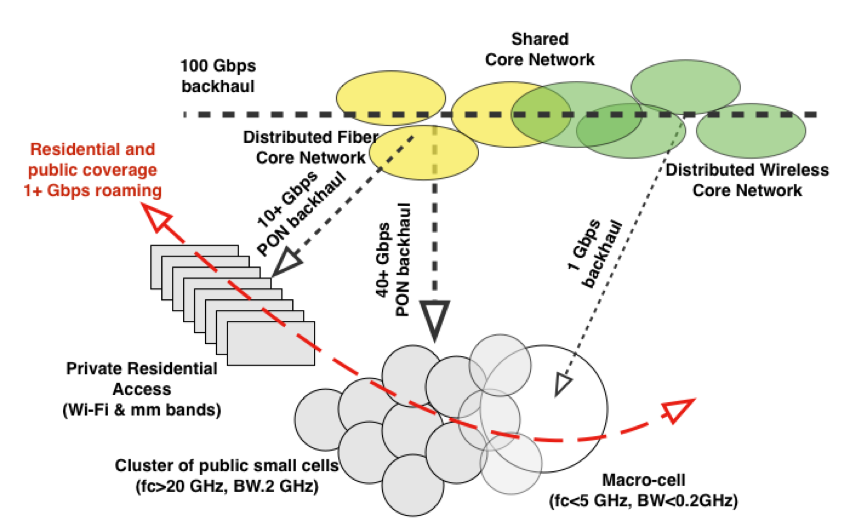Wireless
Non-traditional Stakeholders in 5G Network Developments

With the growth of mobile data consumption, the mobile industry is embarking on its next evolution of technology, dubbed 5G referring to fifth generation mobile networks. The global wireless community has high expectations from 5G networks in terms of end user experience. Goals include achieving lower latencies and increased capacities by at least one order of magnitude in addition to radically new use cases for the technology.
3GPP, the standard development organization (SDO) that drives mobile wireless standards development, has been leading global efforts for the first four generations of wireless networks. The developments in 3GPP have focused on addressing the requirements of mobile networks who have been the primary beneficiaries of these technology evolutions.
CableLabs Participates in 3GPP Discussions
CableLabs has been actively involved with 3GPP because 5G networks will require tighter integration between fixed and mobile networks. The cable industry will play a role in the success of 5G network deployments.
More than half of the global vendors, mobile network operators and research entities who contributed to the 3GPP RAN 5G Workshop in September 2015 indicated that an efficient M2M/IOT support, coexisting with other forms of high capacity traffic, are expected to be a major use case for 5G networks. Specifically, CableLabs’ contribution to the this meeting outlined a “one user, one network” paradigm which allows the user to seamlessly roam between the fixed/pedestrian home/office environment and outdoor mobile environments. Additionally, it is crucial that the cable industry be involved, given the criticality of 10+ Gbps backhaul support of 5G.
Examples of M2M/IoT use cases that are expected to bring non-traditional players to the 5G development table span:
- Small appliances vendors
- Local, provincial and federal/national governments, employing different security, traffic and city wide monitoring operations
- Car manufacturers
- Utilities (water, hydro, gas)
- Industries employing sensor nodes on a large scale (energy, chemical etc)
The vast majority of the participants expected that the spectrum expansion into millimetric wave-bands is expected to be the main focus of 5G development.
The Advantages of 5G
In addition to the large bandwidths (1-4 GHz) made available in the new FCC allocated cm/mm spectra, 5G networks are expected to make effective use of large hybrid beam-forming / MIMO technologies, new modulations and coding schemes. Harnessing these technologies will allow the 5G base stations to transmit in multiple Gbps. This level of performance will require significant backhaul capabilities. For example, technologies like Coordinated MultiPoint can optimize the inter-cell interference at the cell edge and improve a user’s throughput. In return, such an implementation would require the backhaul/fronthaul to carry 10+ Gbps of data, at very low latency.
The cable industry, with its deep fiber and HFC networks capable of supporting large capacities, is well positioned to leverage 5G technologies and drive a new level of mobile experience. In return for the “one user, one network” environment, requirements might include:
- A re-usable access network (between the fixed and wireless networks)
- A distributed core network capability such as the example shown in Figure (1).
Figure 1. Example of a distributed core network architecture backed by a re-usable access network.
All of the above point to the fact that 5G networks will require multiple stake-holders closely collaborating to deliver the targeted promises of 5G. This collaboration could be across various areas such as the convergence of fixed and wireless networks, and efficient support of M2M/IOT use cases.
Based on the above, for 5G networks to be able to deliver the targeted requirements across various industries, it is reasonable to expect changes in the technology development landscape of 5G in comparison to previous generations of mobile wireless standards. Traditional mobile industry players will need to work hand in hand with non-traditional players in the development of 5G networks’ technologies and standards. For these reasons, CableLabs is contributing to the ongoing formation of 5G network architectures.
Attend our Inform[ED] Wireless Conference to Learn More
We will be continuing the discussion of the role that the cable industry will play in 5G networks’ future at our Inform[ED] Wireless Conference in New York City on April 13.
Dorin Viorel is a Principal Wireless Architect at CableLabs.
Belal Hamzeh, VP of Wireless Technologies, CableLabs, also contributed to this article.


